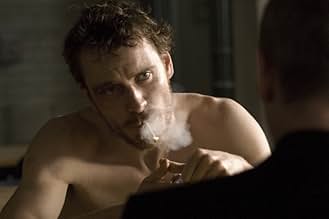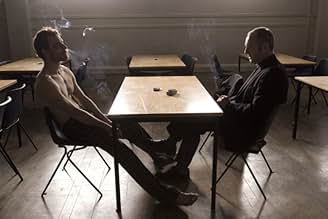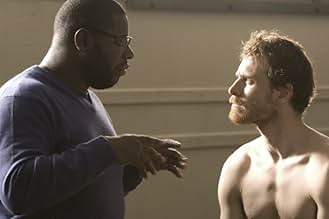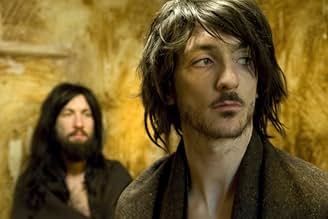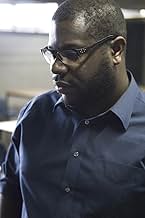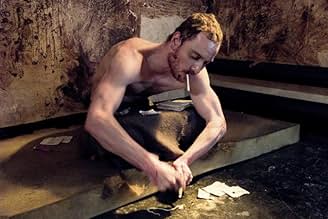Der irische Republikaner Bobby Sands führt die Häftlinge eines nordirischen Gefängnisses in einen Hungerstreik.Der irische Republikaner Bobby Sands führt die Häftlinge eines nordirischen Gefängnisses in einen Hungerstreik.Der irische Republikaner Bobby Sands führt die Häftlinge eines nordirischen Gefängnisses in einen Hungerstreik.
- Regie
- Drehbuch
- Hauptbesetzung
- 1 BAFTA Award gewonnen
- 49 Gewinne & 39 Nominierungen insgesamt
Empfohlene Bewertungen
1981.
The H block in Belfast's Maze Prison.
This film captures the development and escalation of protest by the 'political' prisoners held here as things moved through 'The 'Blanket protest' onto 'The Dirty Protest" and finally to 'The Hunger Strikes' that claimed Bobby Sands and eight of his compatriot's lives.
As the end credits of the film show, the enemy, in the form of Margaret Thatcher was 'not for turning' and did not grant political status to these men that she considered no more than murderers. They did, however, lead to many concessions - bit by bit.
This astounding movie falls into three very clear sections; the gut wrenching blanket and dirty protest; a long and deeply personal conversation (in one 20 minute take) between Sands and his priest where Sands is asked to justify and then walk away from the impending hunger strike; and finally Sands' ordeal itself.
Each section has a different pace and personality. Each is desperate in its own way.
This film pulls few punches. The stench of human excrement is almost palpable in the opening act and the way in which Michael Fassbender brings Sands' death to the screen is almost unbearable.
But the real triumph of the film is that it takes no political sides and makes no judgements but does not sit on the fence. How? Because it invokes the viewer to do that themselves. Sands is neither a figure to pity or to vilify. It really is quite remarkable that the artist Steve McQueen can achieve this so consistently.
And this is art with a capital A. Every scene is stunningly rendered. The pace, at times snail-like, allows you consider in real detail the situation these men found themselves in (or created however you want to look at it).
Fassbender's performance is miraculous.
McQueen though, is the star of the show. One scene in particular when the men slop out by pouring their night's urine under the doors of the corridor simultaneously is quite beautiful, as is the Hirst-like art that some of them create from their excrement (that's what makes up the poster image).
Film of the year. No contest.
Incidentally we saw it in the DCA's Cinema 2. What a cracking screen.
(As we scoffed coffee and fudge doughnuts. How's that for irony?)
The H block in Belfast's Maze Prison.
This film captures the development and escalation of protest by the 'political' prisoners held here as things moved through 'The 'Blanket protest' onto 'The Dirty Protest" and finally to 'The Hunger Strikes' that claimed Bobby Sands and eight of his compatriot's lives.
As the end credits of the film show, the enemy, in the form of Margaret Thatcher was 'not for turning' and did not grant political status to these men that she considered no more than murderers. They did, however, lead to many concessions - bit by bit.
This astounding movie falls into three very clear sections; the gut wrenching blanket and dirty protest; a long and deeply personal conversation (in one 20 minute take) between Sands and his priest where Sands is asked to justify and then walk away from the impending hunger strike; and finally Sands' ordeal itself.
Each section has a different pace and personality. Each is desperate in its own way.
This film pulls few punches. The stench of human excrement is almost palpable in the opening act and the way in which Michael Fassbender brings Sands' death to the screen is almost unbearable.
But the real triumph of the film is that it takes no political sides and makes no judgements but does not sit on the fence. How? Because it invokes the viewer to do that themselves. Sands is neither a figure to pity or to vilify. It really is quite remarkable that the artist Steve McQueen can achieve this so consistently.
And this is art with a capital A. Every scene is stunningly rendered. The pace, at times snail-like, allows you consider in real detail the situation these men found themselves in (or created however you want to look at it).
Fassbender's performance is miraculous.
McQueen though, is the star of the show. One scene in particular when the men slop out by pouring their night's urine under the doors of the corridor simultaneously is quite beautiful, as is the Hirst-like art that some of them create from their excrement (that's what makes up the poster image).
Film of the year. No contest.
Incidentally we saw it in the DCA's Cinema 2. What a cracking screen.
(As we scoffed coffee and fudge doughnuts. How's that for irony?)
Steve McQueen, a noted young British artist, has made a powerful first film about the Irish prisoners in H-Block of Maze Prison, Northern Ireland, and the hunger strike and death of Bobby Sands in 1981. The images are searing, both horrible and beautiful (McQueen is aware from Goya that images of war can be both), and much of the film is non-verbal, but the action is broken up by a centerpiece tour-de-force debate between Sands (Michael Fassbender) and Father Dominic Moran (Liam Cunningham) that is as intensely verbal as the rest is wordless. In Irish playwright Enda Walsh's rapid-fire dialogue quips are exchanged, then passionate declarations, in a duel that's like a killer tennis match: watching, we listen, and the camera, hitherto ceaselessly in motion, becomes still. Hunger, with its rich language, intense images, and devastating story, is surely one of the best English-language of the year, and it understandably won the Camera d'Or at Cannes for the best first film. Like the American Julian Schnabel, Steve McQueen is another visual artist who has turned out to be an astonishingly good filmmaker.
Faithful to the physical details of the H-blocks and the treatment of the prisoners, the film is still honed down to essentials and includes a series of sequences so intense it may take viewers a long time to digest them. As the film opens, an officer of the prison, Raymond Lohan (Stuart Graham), follows his normal routine. His knuckles are bloody and painful; later we learn why. His wife brings him sausage, rasher, and eggs.
Davey Gillen (Brian Milligan) a young Irish republican prisoner, tall, gaunt, and Christ-like, is brought into the prison. He refuses to wear the prison uniform, so, joining the Blanket protest, he's put in with fellow "non-conforming" prisoner Gerry Campbell (Liam McMahon) in a cell whose walls are smeared with feces. Those of us who were around when these events happened (Steve McQueen was 12, and remembers the coverage), remember them so well we could have seen these walls. Campbell shows Gillen hot to receive "comms" (communications) from visitors and pass them to their leader Bobby Sands at Sunday mass.
When prisoners agree to wear civilian garments, they're mocked by the "clown clothes" they're handed out and riot, screaming and yelling and tearing up everything in their cells. They also periodically collect their urine and pour it under their cell doors out into the prison hallway where the guards must walk. The result is a brutal punishment by the prison in which the prisoners are taken out to the hallway and beaten naked by a gauntlet of police in riot gear. An eventual repercussion is that Raymond Lohan is shot dead while visiting his catatonic mother in a home.
A poetic flourish of the meeting between Sands and Father Moran is Sands's story of going to the country as a Belfast boy on the cross country team and going down to a woods and a stream where he is the only one who dares to put a dying foal out of its misery by drowning it. The images this tale evoke become the objective correlative of Bobby's last thoughts when he is dying in the prison hospital.
The central issue was being treated as political prisoners. From 1972, paramilitary prisoners had held some of the rights of prisoners of war. This ended in March 1976 and the republican prisoners were sent to the new Maze Prison and its "H-blocks" near Belfast. Special Category Status for prisoners convicted of terrorist crimes was abolished by the English government. Hunger doesn't focus on ideology or public policy, other than to have the voice of Margaret Thatcher, in several orotund declarations, adamantly denying the validity of the republicans' cause or status. The Sands-Moran debate is more about feelings and tactics.
Another powerful contrast comes when Sand goes on the hunger strike and is taken to the clean, quiet setting of the hospital where he is lovingly cared for and visited by a good friend and his parents, who're even allowed to sleep there during his last days. Sands' condition is dramatic, heightened by horrible sores, and a report to his parents of the rapid damage to internal organs and heart that his fast will cause.
It was McQueen's decision to eschew a screenwriter in favor of a playwright for the script, and his choice of his near-contemporary Enda Walsh, an Irishman resident in London, was a wise one. McQueen determined the structure and inspired the paring down. Walsh makes the central verbal scene sing. Its intensity is such that it has no trouble at all competing with the harsh prison scenes. It is brilliant stroke. Great theater you could say, but the film's contribution is to make the whole train of events alive and human at a time when they are acutely relevant to the post 9/11 world of Guantanamo and Abu Ghraib.
Shown at Cannes, Telluride, and Toronto, included in the New York Film Festival 2008.
Faithful to the physical details of the H-blocks and the treatment of the prisoners, the film is still honed down to essentials and includes a series of sequences so intense it may take viewers a long time to digest them. As the film opens, an officer of the prison, Raymond Lohan (Stuart Graham), follows his normal routine. His knuckles are bloody and painful; later we learn why. His wife brings him sausage, rasher, and eggs.
Davey Gillen (Brian Milligan) a young Irish republican prisoner, tall, gaunt, and Christ-like, is brought into the prison. He refuses to wear the prison uniform, so, joining the Blanket protest, he's put in with fellow "non-conforming" prisoner Gerry Campbell (Liam McMahon) in a cell whose walls are smeared with feces. Those of us who were around when these events happened (Steve McQueen was 12, and remembers the coverage), remember them so well we could have seen these walls. Campbell shows Gillen hot to receive "comms" (communications) from visitors and pass them to their leader Bobby Sands at Sunday mass.
When prisoners agree to wear civilian garments, they're mocked by the "clown clothes" they're handed out and riot, screaming and yelling and tearing up everything in their cells. They also periodically collect their urine and pour it under their cell doors out into the prison hallway where the guards must walk. The result is a brutal punishment by the prison in which the prisoners are taken out to the hallway and beaten naked by a gauntlet of police in riot gear. An eventual repercussion is that Raymond Lohan is shot dead while visiting his catatonic mother in a home.
A poetic flourish of the meeting between Sands and Father Moran is Sands's story of going to the country as a Belfast boy on the cross country team and going down to a woods and a stream where he is the only one who dares to put a dying foal out of its misery by drowning it. The images this tale evoke become the objective correlative of Bobby's last thoughts when he is dying in the prison hospital.
The central issue was being treated as political prisoners. From 1972, paramilitary prisoners had held some of the rights of prisoners of war. This ended in March 1976 and the republican prisoners were sent to the new Maze Prison and its "H-blocks" near Belfast. Special Category Status for prisoners convicted of terrorist crimes was abolished by the English government. Hunger doesn't focus on ideology or public policy, other than to have the voice of Margaret Thatcher, in several orotund declarations, adamantly denying the validity of the republicans' cause or status. The Sands-Moran debate is more about feelings and tactics.
Another powerful contrast comes when Sand goes on the hunger strike and is taken to the clean, quiet setting of the hospital where he is lovingly cared for and visited by a good friend and his parents, who're even allowed to sleep there during his last days. Sands' condition is dramatic, heightened by horrible sores, and a report to his parents of the rapid damage to internal organs and heart that his fast will cause.
It was McQueen's decision to eschew a screenwriter in favor of a playwright for the script, and his choice of his near-contemporary Enda Walsh, an Irishman resident in London, was a wise one. McQueen determined the structure and inspired the paring down. Walsh makes the central verbal scene sing. Its intensity is such that it has no trouble at all competing with the harsh prison scenes. It is brilliant stroke. Great theater you could say, but the film's contribution is to make the whole train of events alive and human at a time when they are acutely relevant to the post 9/11 world of Guantanamo and Abu Ghraib.
Shown at Cannes, Telluride, and Toronto, included in the New York Film Festival 2008.
I saw Hunger at TIFF. I heard it was a hot ticket, and pre-festival buzz was good so I was elated when I got tickets. McQueen uses very little dialogue throughout the film, instead choosing to communicate through strong visuals and raw imagery. The film is less about the politics behind the IRA conflict, and more about the suffering of the prisoners and the dehumanization of them at the hands of the guards. It is not an easy film to watch. The imagery is so strong and raw that I couldn't help but grimace during some parts. The lady sitting next to me had her hands covering her face at one point, and was visibly crying. McQueen holds nothing back. The prisoners are shown smearing excrement over their cell walls and pouring their prison food over the floor until it goes bad and are covered with bugs. McQueen demonstrates the unwillingness of the prisoners to be stripped of their dignity (by conforming to prison demands), despite being stripped of everything else. There are some very long takes with no dialogue, with a particularly long one of a prisoner cleaning himself for what seemed like forever. The atmosphere in these scenes is so visceral that one can almost feel the filth and smell the stench of the prisoners. There is also one particularly brutal scene where the guards make two lines, and each nonconforming prisoner is marched through the middle while being repeatedly beaten by batons. Afterward, one of the officers walks outside and weeps. It is then that we learn to see the guards as human; perhaps even victims trapped within a conflict with no resolution in sight.
The story of Bobby Sands takes precedent about half way into the film. The most dialogue in the films occurs during the scenes between Sands and his priest. Unfortunately the Irish accents are thick, and I found the scene hard to decipher. The final scenes in the film are tough to watch as we witness Sands' slow dissent into the throes of starvation. It is hard to imagine anyone subjecting themselves to such suffering, yet 9 other prisoners followed suit. Fassbender is very good in the role; giving us a character that is unrelenting in his choices and beliefs. He genuinely believes his suffering serves a purpose, and though some may disagree with his choices, one can't help but admire his conviction.
Hunger is an artfully done film, which is no surprise considering McQueen is a visual artist. It is visually moving and challenging piece of work. It is hard to believe that it's his first feature, and easy to understand why it won the Camera d'or, and now the Discovery award at TIFF. I would have preferred a bit more back story to the conflict (I know close to nothing of its history), but then again, choosing to put more focus on politics may have taken away from other elements of the film. Lastly, I appreciate McQueen's unwillingness to take a stand on the conflict/protest in his film. He allows the viewers to make their own judgments; he's merely here to tell the story.
The story of Bobby Sands takes precedent about half way into the film. The most dialogue in the films occurs during the scenes between Sands and his priest. Unfortunately the Irish accents are thick, and I found the scene hard to decipher. The final scenes in the film are tough to watch as we witness Sands' slow dissent into the throes of starvation. It is hard to imagine anyone subjecting themselves to such suffering, yet 9 other prisoners followed suit. Fassbender is very good in the role; giving us a character that is unrelenting in his choices and beliefs. He genuinely believes his suffering serves a purpose, and though some may disagree with his choices, one can't help but admire his conviction.
Hunger is an artfully done film, which is no surprise considering McQueen is a visual artist. It is visually moving and challenging piece of work. It is hard to believe that it's his first feature, and easy to understand why it won the Camera d'or, and now the Discovery award at TIFF. I would have preferred a bit more back story to the conflict (I know close to nothing of its history), but then again, choosing to put more focus on politics may have taken away from other elements of the film. Lastly, I appreciate McQueen's unwillingness to take a stand on the conflict/protest in his film. He allows the viewers to make their own judgments; he's merely here to tell the story.
The movie is a timely piece of film-making in this era of Abu Ghraib and Guantanamo Bay. I have to admit my prejudice for the film because of my past as one of the prisoners depicted in the film. Long Kesh or the Maze as the British infamously renamed it was the Abu Ghraib of its day. One stark difference though: unlike Abu Ghraib, no one has ever been charged with the horror and relentless torture inflicted upon naked, defenceless prisoners in Long Kesh. The film is uncompromising in its examination of the events leading up to and beyond the Hunger Strike. Michael Fassbender is frighteningly real. But I will leave it up to the words of Peter Bradshaw in the Guardian to sum it up: 'Hunger is raw, powerful film-making and an urgent reminder of this uniquely ugly, tragic and dysfunctional period in British and Irish history
'
It's 1981. Raymond Lohan (Stuart Graham) is a guard in the Maze Prison, Northern Ireland. Davey Gillen is a new IRA prisoner who refuses to wear prison uniforms. He's put in with Gerry who has smeared the cell with his own feces. They smuggle things in and out of the prison. Bobby Sands (Michael Fassbender) leads the prisoners in a hunger strike.
It's quiet film and full of little details. It doesn't wallow in the brutality but lets it envelop the movie. There is a realism in the movie that is more powerful than any flash or action sequence. One really gets the sense of dehumanization. Dialog is sparse but there is a great discussion between Sands and Father Dominic Moran. This is quietly brutal and some great performances including Fassbender.
It's quiet film and full of little details. It doesn't wallow in the brutality but lets it envelop the movie. There is a realism in the movie that is more powerful than any flash or action sequence. One really gets the sense of dehumanization. Dialog is sparse but there is a great discussion between Sands and Father Dominic Moran. This is quietly brutal and some great performances including Fassbender.
Wusstest du schon
- WissenswertesHunger is known for its unbroken 17 minute 10 second continuous shot, in which Catholic priest Father Dominic Moran tries to talk Bobby Sands out of the Hunger Strike he and his fellow 75 IRA members plan to start. The camera remains in the same position throughout the scene. To prepare, Liam Cunningham moved into Michael Fassbender's apartment, and they rehearsed the scene 12-15 times per day. On the first day of filming, the actors got it perfect after 4 takes.
- PatzerThatcher's speech that says "the men of violence have chosen in recent months to play what may well be their last card" is shown in the film when the hunger strike is beginning, but it was actually made after Bobby Sands had died. It was made on 28th May 1981. Bobby Sands died on 5th May 1981.
- Zitate
Bobby Sands: I have my belief, and in all its simplicity that is the most powerful thing.
- VerbindungenFeatured in Front Row: Michael Fassbender/Kate Winslet (2017)
- SoundtracksIndustry
Performed by Maya Beiser
Composed by Michael Gordon
Published by Red Poppy in association with G. Schirmir, Inc.
Top-Auswahl
Melde dich zum Bewerten an und greife auf die Watchlist für personalisierte Empfehlungen zu.
Details
- Erscheinungsdatum
- Herkunftsländer
- Offizieller Standort
- Sprachen
- Auch bekannt als
- Tù Khổ Sai
- Drehorte
- Produktionsfirmen
- Weitere beteiligte Unternehmen bei IMDbPro anzeigen
Box Office
- Budget
- 1.500.000 £ (geschätzt)
- Bruttoertrag in den USA und Kanada
- 154.084 $
- Eröffnungswochenende in den USA und in Kanada
- 1.980 $
- 7. Dez. 2008
- Weltweiter Bruttoertrag
- 3.185.113 $
- Laufzeit
- 1 Std. 36 Min.(96 min)
- Farbe
- Sound-Mix
- Seitenverhältnis
- 2.35 : 1
Zu dieser Seite beitragen
Bearbeitung vorschlagen oder fehlenden Inhalt hinzufügen




